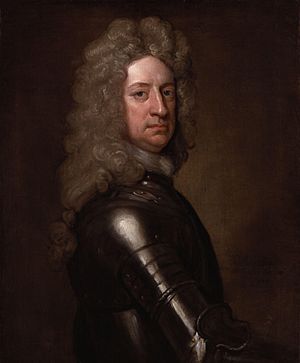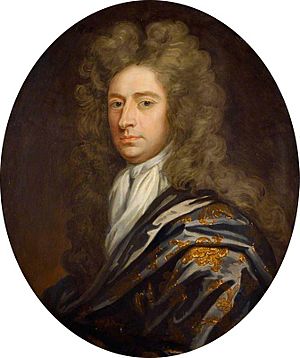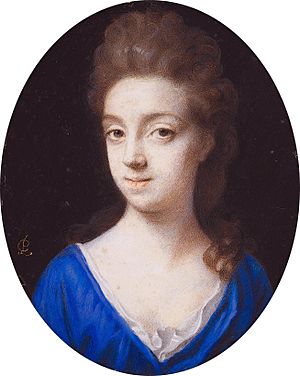Charles Mordaunt, 3rd Earl of Peterborough facts for kids
Charles Mordaunt, 3rd Earl of Peterborough and 1st Earl of Monmouth (born in 1658, died on October 25, 1735) was an important English army officer and politician. He was a member of the Whig political party. Charles Mordaunt came from a noble family. His father was John Mordaunt, 1st Viscount Mordaunt. In 1659, his father was given the titles Viscount Mordaunt of Avalon and Baron Mordaunt of Reigate.
Contents
Early Life and Political Beginnings
Charles Mordaunt went to Tonbridge School and later studied at Christ Church, Oxford. When he was about 16, he joined Sir John Narborough's navy fleet in the Mediterranean Sea. He first showed his bravery in battle by helping to destroy the fleet of the ruler of Tripoli.
In 1675, his father passed away. Charles Mordaunt then inherited his father's title, becoming Viscount Mordaunt.
After returning from a trip to Tangier, he became very active in politics. He was a strong supporter of the Whig party and strongly opposed James, Duke of York, who was next in line for the throne. When James became king, Mordaunt's strong opposition made him leave England. He went to Holland in 1686.
In Holland, he suggested to William of Orange that he should invade England. William was careful and didn't agree to Mordaunt's plan at first. However, William decided to keep Mordaunt close. When William sailed to England, Mordaunt went with him. After William became King of England, Lord Mordaunt received many honors.
Becoming First Lord of the Treasury
On February 14, 1689, Charles Mordaunt became a member of the Privy Council. This was a group of important advisors to the king. On April 8 of the same year, he was made First Lord of the Treasury. This meant he was in charge of the country's money. A day later, he received another important title: 1st Earl of Monmouth. This title had been held by his family before.
He left the Treasury position in less than a year. But he stayed close to the King and even traveled with him to Holland in 1691. Lord Monmouth was one of 18 noblemen who signed a protest in 1692. They wanted an investigation into how the war was being fought. He also helped bring back a bill for parliaments to meet every three years.
Later, in 1697, he faced trouble. He was accused of saying disrespectful things about the king and was sent to the Tower of London. He stayed there until March 30, 1697, and lost his jobs. However, he found some comfort on June 19, 1697. He inherited the Earldom of Peterborough after his uncle, Henry Mordaunt, passed away.
Leading Troops in Spain
After being released from the Tower, he spent four years mostly out of public life. But when Queen Anne became queen, he quickly returned to politics. In 1702, he faced criticism from the House of Commons for trying to influence an election.
To keep his energetic spirit from causing problems at home, the government sent him on an important mission. In 1705, he was appointed to lead an expedition to Spain during the War of the Spanish Succession.
He became the main commander of the land forces in April 1705. He also shared command of the fleet with Sir Cloudesley Shovell. He arrived in Lisbon in June 1705. In August, he sailed to Barcelona to conquer Catalonia. He then began to besiege the city.
For some weeks, the fighting was not very strong. Peterborough suggested moving the troops to Italy. But the strong will of Archduke Charles of Austria won out. By October 14, the city of Barcelona fell to his forces.
It was sometimes hard to understand Peterborough's actions during this campaign. He seemed unsure about putting an Austrian prince on the Spanish throne. When Charles decided to join Lord Galway's troops and march to Madrid, Peterborough's advice again caused delays. He changed his mind about the best route and waited several weeks before joining Galway.
Because of disagreements among the army leaders, Lord Peterborough was called back to England in March 1707. He was accused of not doing his job well and going beyond his authority. His actions became a big debate between the Tories, who supported him, and the Whigs, who did not.
Later Years and Retirement
When he returned to England, he joined the Tories. They praised him, comparing him favorably to other Whig generals. The disagreements between Peterborough and other commanders who served in Spain were debated in the House of Lords. The majority supported Peterborough. After some strong speeches, a resolution was passed saying he had done "many great and eminent services." He also received votes of thanks in 1708.
His new friends sent him on a mission to Vienna. He was also given command of a cavalry regiment and became a Knight of the Garter in 1713. When George I became king, Lord Peterborough lost his political influence. He passed away in Lisbon on October 25, 1735, after a long illness. His body was brought back to England and buried in Turvey, Bedfordshire.
Family Life
Lord Peterborough was a short man, but he was full of energy. People said he traveled more than almost anyone in Europe. He was a good speaker in debates and brave in battle. However, his changing political views sometimes hurt his influence. His energy in the field was sometimes wasted because he didn't always work well with his fellow commanders.
In 1678, Charles Mordaunt married Carey Fraser. She was the daughter of Sir Alexander Fraser. Carey passed away on May 13, 1709. They had three children:
- Lady Henrietta Mordaunt (died 1760), who married the 2nd Duke of Gordon. They had children, and her grandson later inherited the Mordaunt barony.
- John Mordaunt, Viscount Mordaunt (around 1681–1710), who was an ancestor of the 4th Earl.
- Captain Hon. Henry Mordaunt, RN (died February 27, 1710).
In 1722, he secretly married Anastasia Robinson (around 1695–1755). She was a very famous and beautiful singer. For some time, their marriage was not publicly known, and she lived separately from him. She continued to perform on stage until 1724.
It seems a second marriage ceremony might have happened shortly before his death in 1735. He did not have any children with his second wife. Anastasia, Countess of Peterborough and Monmouth, lived until 1755.
See also
 In Spanish: Charles Mordaunt para niños
In Spanish: Charles Mordaunt para niños
- Mordaunt Cracherode
- William Chaloner




